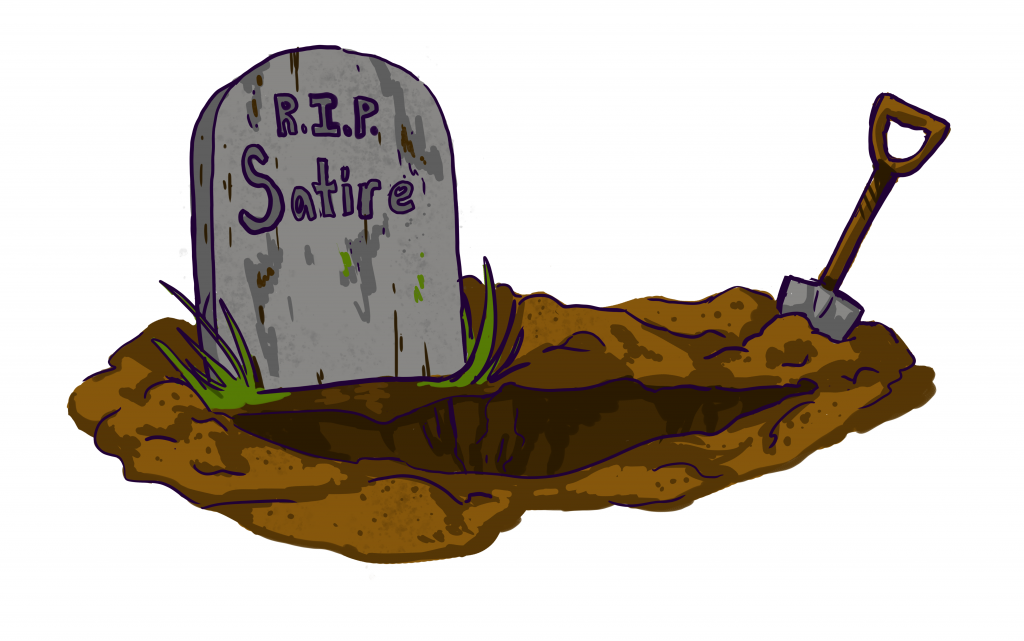
According to dictionary.com, “Satire is the use of irony, sarcasm, ridicule or the like, in exposing, denouncing, or deriding vice and folly.”
The purpose of satire in a modern society should be to create stories that mirror reality in a way that helps reveal truth or consequences associated with actions in the real world. However, if reality is so strange that it is indistinguishable from satire, does satire still function as it’s intended to? Is satire dying? Or, has it reached an evolutionary tipping point?
Critics believe satire is dying for a variety of different reasons. Some journalists have been saying stuff like: Satire is dead! And we’re the ones that killed it. It’s going to take a thousand years to mop up all this blood! Ted Gioia from the Daily Beast says it’s because of the changing sensibilities of younger audiences.
“Face it, audiences today are easily offended by satire—and the younger members of the audience (coveted by the entertainment industry) have the thinnest skins of all.” Because of this, Gioia says that satire has lost its necessary edge. “I suspect that most comedians nowadays are looking to be less edgy, not more so. And satire needs to be edgy to survive, otherwise it collapses into mere parody, a much lesser form of humor.” In fairness, who’s to say that Gioia is an authority? A close reader might say, “Ted Gioia is an out-of-touch elitist that probably has grown kids that don’t talk to him anymore. Anyone who talks about ‘lesser forms of humor,’ is so far up their own ass they can see what they had for breakfast this morning.” But, you’d have to be an elitist yourself not to recognize that a mark of successful satire is a balance between absurdity and the biting criticism it delivers on a given topic.
Another major criticism of modern satire is that it goes after the wrong targets. Emma Burnell articulates this in her piece for the Independent, “Satire hasn’t had any real ‘effect’ on political culture for decades. Just as Ben Elton didn’t bring down ‘Mrs. Thatch’, nor did Rory Bremner stop the Iraq war, both performed generally for audiences who enjoyed cheering them on rather than those who were intended to be on the sharp end of their wit.” In this case, a close reader might say, “Wait, isn’t political journalism one big cesspool of confirmation bias? How could they make the claim that satire panders to an audience when they make their living doing just that?”
Even if that’s a fair point, it makes sense the demographic that enjoys satire is not usually the intended target of it. People tend to listen to stuff they agree with.
Other critics like Ed Mazza from The Huffington Post reinforce the idea that real-life events predicted by satire highlight the decline of the genre. In an article entitled, “Satire Is Dead: Archie Bunker Predicted Trump’s Gun Plan Back In 1972,” Mazza talks about President Trump’s recent plan to arm school teachers in the wake of the Parkland school shooting. The plan to arm teachers mirrors a similar proposal from Archie Bunker on the popular television series “All in the Family” back in 1972. Again, a close reader might ask something like, “Is it fair to make a claim that an ancient literary tradition is dead, just because a TV show’s plot was eerily similar to real events?” Maybe not. And yet, this blurring of reality and fiction seems to reflect how reality has beaten satire to the punch.
One of the keys to understanding how reality has mirrored satire is take a look at some examples. Many modern products, programs and events unintentionally appear as though they are satirical, even though they aren’t.
First, is “Trumpy Bear.” It’s exactly what it sounds like: A teddy bear that has President Trump’s hair on it. According to the commercial, the bear was born on Flag Day and is equipped with a secret compartment in his back that holds an American flag blanket. The announcer even mentions how customers can use the flag to wrap themselves in the warm comforting embrace of red, white and blue.
They use an appeal to the religious customer base. “God bless America, and God Bless Trumpy Bear,” a woman says while cradling the doll. Even an appeal to the hyper-masculine biker dudes/military guys, “Trumpy Bear sits proudly at the front of the motorcycle for all the world to see.” The announcer says as we’re shown an image of the bear sitting in between the handlebars of a bike, “I’m a former marine, and I’m proud to have Trumpy Bear ride by my side.” The man in the tight T-shirt and sunglasses says with Trumpy Bear sitting upright in his lap.
The ad is so surreal that the second search result on Google is a link to fact-checking website Snopes asking if Trumpy Bear is a joke. The overt way in which it seems to highlight the more ridiculous aspects of the product and the customers that might buy it is why it seems so much like satire.
Another example is the pro-gun church from Pennsylvania that held a ceremony where participants were asked to bring their AR-15s as a part of the service. Their view is that the AR-15 is actually related to imagery in the bible and it is meant to represent their ability to protect themselves and others from evil. It really isn’t the most ridiculous interpretation of the bible ever. But, the believability of it is what makes it so interesting. That’s how good satire functions. The premise is just ridiculous enough to be recognized as absurd, and the reasoning behind the absurdity is made comically real. This has always been satire’s power. To say, “this is a joke, but it’s an exaggeration of a realistic outcome.” When that balance already exists inherently in the story there is no need to exaggerate it.
Additionally, “South Park” is one of the biggest satirical juggernauts of the past two decades. They are also experiencing difficulties with satirizing inherently wild events. Trey Parker, the co-creator and voice of Cartman and Stan, spoke about these difficulties in a podcast interview:
“If you have like a little monkey and it’s running himself into the wall over and over and you’re like, ‘That’s funny, but how am I gonna make fun of the monkey running himself into the wall?’ I can discuss the monkey running himself into the wall, I can copy the monkey running into the wall, but nothing’s funnier than the monkey just running himself into the wall.”
The analogy here encompasses why this is a problem. If it’s already funny or wild on its own, there is nothing left to do but poorly imitate it.
If this is the case, what can be done moving forward to help right the course and return satire to its former glory? Is that even realistically possible? For now, the answer is still maybe.
First, satirists need to ask, “How can we avoid pandering to an overly agreeable audience and reach the audience it is technically meant for?”
Next, “How can we satirize ourselves?”
And, last, “How do we find a way to deliver offensive or divisive opinions to an audience that is hypersensitive to them?”
If notable modern satirists can manage to regroup and adapt to the changing nature of pop-culture then they can start to re-popularize it as a mechanism of societal change and entertainment. Eventually satire will regain its position at the heart of political discourse. The United States can champion its use as a means of problem solving across the world and inspire other countries to do the same. The UK will follow suit, but in a way that mainstream U.S. audiences won’t quite understand until an American version comes out. Before anyone knows it, presidential candidates, possible prime ministers and politicians of all shapes and sizes will be required to create satirical skits that lampoon their competitors in clever and poignant ways to even be considered for office.
With persistence and a healthy sense of humor, all forms of argumentation with be resolved through satirical media. Violence and war will become a thing of the past as we usher in a new satirical passive-aggressive golden-age of humanity that will redeem the sins of our ancestors.






















